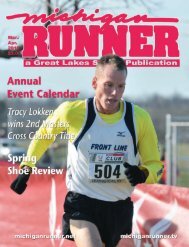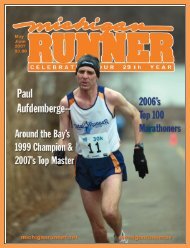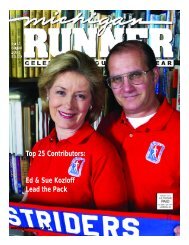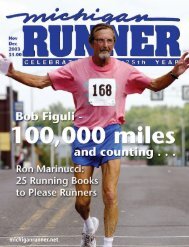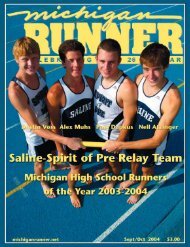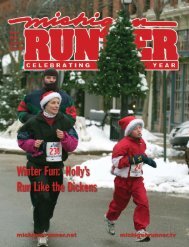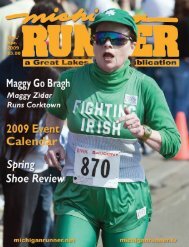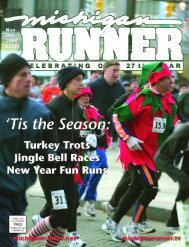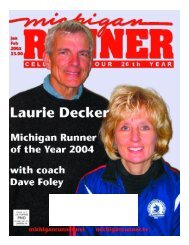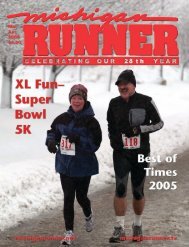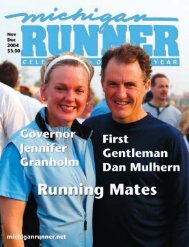Create successful ePaper yourself
Turn your PDF publications into a flip-book with our unique Google optimized e-Paper software.
idge reluctantly<br />
agreed to partner with<br />
this venture as long as<br />
the other party would<br />
as well. A preliminary<br />
measurement of the<br />
course was made.<br />
However, a labor dispute<br />
at the bridge was<br />
followed by a Bridge<br />
Authority statement<br />
that the person who<br />
had given approval to<br />
use the bridge did not<br />
have the power to do<br />
so. <strong>This</strong> ended the<br />
Ambassador Bridge’s<br />
involvement with the<br />
race. When this information<br />
reached the<br />
tunnel officials, they,<br />
too, attempted to pull<br />
out. However, during<br />
a tense meeting, Neal<br />
Shine successfully convinced<br />
them to give the<br />
race a chance for one<br />
year.<br />
With the loss of<br />
the bridge, a completely<br />
new route was<br />
charted. The<br />
marathon would now<br />
start in Windsor on<br />
Riverside Drive in the<br />
shadow of the<br />
Ambassador Bridge,<br />
proceed to the tunnel<br />
and into Detroit. The<br />
route would head east<br />
Photo by Detroit Free Press, courtesy of Ed Kozloff<br />
on Jefferson Avenue<br />
into the Grosse<br />
Pointes, turn at Kerby,<br />
and return to the finish<br />
on Belle Isle.<br />
Starting in Canada<br />
presented an added concern – transporting<br />
runners to the Windsor starting point.<br />
Eventually, two dozen city buses took on the<br />
job. An additional issue, faced by only one<br />
other race in the country, concerned the<br />
crossing of international borders. Excellent<br />
cooperation between United States and<br />
Canadian Immigration and Customs officials,<br />
along with the government officials of both<br />
Detroit and Windsor, made for many lengthy<br />
but productive meetings.<br />
Marathon Day was October 22, 1978.<br />
The day before, a pre-race clinic was held at<br />
the Radisson Cadillac Hotel on Washington<br />
Boulevard from 6:00 p.m. to 11:00 p.m. A<br />
spaghetti dinner for $3.00 was offered and<br />
the evening included running films, exhibits,<br />
a medical clinic, merchandise for sale, and<br />
Dick Purtan who was the featured Master of<br />
Ceremonies. Furthermore, the announcement<br />
was to be made that the race had received<br />
certification approval just the day before.<br />
Despite the meticulous planning, however,<br />
coordinators were met with two problems as<br />
At the first Detroit Free Press Marathon in 1978 race winner Robert<br />
McOmber is first through the Tunnel.<br />
the doors were about to open. The hotel had<br />
neglected to set up tables and chairs for the<br />
spaghetti dinner! Everyone had assumed that<br />
if a dinner was being served there would be a<br />
place to sit and eat. A bad assumption!<br />
Nevertheless, there were few complaints as<br />
the crowd sat on the floor to dine. As the<br />
multitudes packed the room, it became<br />
warmer and warmer and more and more<br />
uncomfortable. To get some fresh air, an<br />
official began to open a six-foot window. As<br />
he pushed on it, it broke free from its support<br />
and crashed two floors down to the street!<br />
(The Radisson was in its last days at the time<br />
and was about to close its doors.) Nothing<br />
ruined the evening, however, and the band<br />
played on as everyone enjoyed the premarathon<br />
evening.<br />
On race day, the temperature was 57<br />
degrees for the 9:00 a.m. start. The<br />
marathon runners were lined up in Windsor,<br />
but that was not the only event that day. On<br />
Belle Isle, a thousand runners were entered in<br />
a 10k and a mile which were to start at the<br />
same time. The entry<br />
fee for the marathon as<br />
well as the 10k was<br />
$5.00. There was no<br />
charge for the mile.<br />
The marathon<br />
field – at 1,942 starters<br />
– was over four times<br />
larger than the previous<br />
year, making it the<br />
fifth largest in the<br />
nation for that year.<br />
At the starting line was<br />
Bob McOmber, winner<br />
of the last Motor City<br />
Marathon. <strong>This</strong> was<br />
now his fourth race at<br />
this distance. <strong>In</strong> April,<br />
he had finished 17th at<br />
Boston. Was he still<br />
fit? You bet he was!<br />
He took the lead at a<br />
quarter mile into the<br />
race and never relinquished<br />
it. His<br />
2:17:37 at the finish<br />
was over four minutes<br />
ahead of Mike Heath,<br />
who finished in<br />
2:21:50. Mike’s father,<br />
Larry, finished 20th<br />
overall in 2:35:38.<br />
Their combined time of<br />
4:57:28 set a national<br />
record for a father-son<br />
combination in the<br />
same race.<br />
Erma Tranter,<br />
of Chicago, was equally<br />
impressive with a<br />
women’s victory by<br />
nearly five minutes in<br />
2:55:51. Both winners<br />
took a prize of an allexpense<br />
trip to either<br />
Boston or the<br />
Marathon de Montreal.<br />
The top youngest finisher was Keith<br />
Hanson, 13, an eighth grader at Davis Junior<br />
High in Sterling Heights. After sending a<br />
detailed letter of his training, he had received<br />
special permission to run. He finished in<br />
3:20:0l.<br />
As the runners crossed the finish line,<br />
they were greeted by The University of<br />
<strong>Michigan</strong> Marching Band. Their times and<br />
places were recorded and this information<br />
was fed into Burroughs Corporation computers,<br />
which were considered to be the most<br />
sophisticated means of scoring a race up to<br />
that time. After this input, each runner’s<br />
name, age, city, overall place, and category<br />
place were printed out and posted.<br />
Joe Falls, now with the rival Detroit<br />
News, wrote a glowing report on the race –<br />
often an unusual practice in the newspaper<br />
business. The Detroit Free Press<br />
<strong>In</strong>ternational Marathon had arrived and<br />
would be a distinguished event for years to<br />
come. MR<br />
16 S E P T E M B E R / O C T O B E R 2 0 0 7



